Derek Walcott
Article

A single, homeless, circling satellite: Derek Walcott, 1992 Nobel Prize laureate in literature
by Jöran Mjöberg*
This article was published on 26 June 2001.
Background and youth
Black and white ancestry
Derek Walcott was born in 1930 on St. Lucia, an island then belonging to the British Empire, but which became independent in 1979. St. Lucia has a hybrid British/French culture, having alternated as a colony of either England or France across the centuries. Walcott’s ancestry is also mixed, with both his maternal and paternal grandmothers being black. His mother was a respected teacher at a Methodist infant school while his father died when Derek was only one year old.
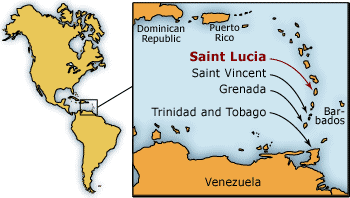
St. Lucia became independent in 1979, but maintains its hybrid British and French culture to this day.
The young painter
His civil servant father had been an amateur painter, and the son has also devoted much of his grown-up life to painting, not to mention the many references to the great names in art all through his literary works. When growing up in Castries, the capital of St. Lucia, young Walcott attended St. Mary’s College where his most important mentor was a painter, Harold Simmons. He soon took an interest in great European artists like Cézanne, Gauguin, and van Gogh.

A 1969 photo of Derek Walcott painting in Trinidad (left) and a self-portrait (oil on canvas) done in 1998.
Photo by Peter Ireson
Published poet at 14, dramatist at 16
While the town of Castries had an Europeanized culture, Afro-Caribbean folk customs and traditions dominated the countryside of St. Lucia. Walcott published his first poem when he was just fourteen. At sixteen he wrote five plays and had his first collection of poetry published. By the age of twenty, Walcott was ready to found a theatre company on his own, the ST. LUCIA ARTS GUILD. In its inaugural year, this company produced his play Henri-Christophe, whose subject was taken from the colonial history of another Caribbean island, namely Haiti.
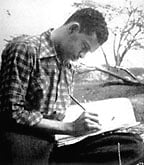
At 16, Walcott wrote five plays.
Copyright © The Bruce King Collection
Academic studies
After graduating from St. Mary’s College, Walcott continued his studies in another part of the Caribbean, on the island of Jamaica, where he attended the University College of the West Indies at Mona. Here he obtained his bachelor’s degree in 1953. At the University College, he was both the editor of the student magazine and the president of MONA DRAMATIC SOCIETY.
The search for an identity
A central theme that runs throughout Walcott’s works is his search for identity. From the beginning, he has intensely felt the antagonisms between the cultural heritage of the Old World and the traditions of the new one. In his critical work Derek Walcott, published in 1999, John Thieme describes the conflicts Walcott has experienced between the positions of European and African, Anglophone and Francophone, Standard English and Creole, and Methodist and Catholic. In the earlier collections of poetry, Thieme traces “a sense of lost perfection, cracked innocence and psychic fragmentation,” which he considers to be a result of the racial divisions of the Caribbean society. In one volume after another, by means of a variety of important poems, Walcott tries to find expressions for the difficulties inherent in Caribbean identity. In “A Far Cry from Africa” (1962) he depicts his desperate dilemma in rather brutal formulations:
The gorilla wrestles with the superman.
I who am poisoned by the blood of both,
Where shall I turn, divided to the vein?
Yet, in his fascinating essay of 1970, “What the Twilight Says,” where he delivers a report about the origin of his interest in the theatre, he sounds more optimistic, hoping to be able to make creative use of his cultural schizophrenia.
In the poem “The Schooner Flight” (1979), Shabine, a Walcott persona, gives an often quoted definition of the identity of a person from a small country in the Caribbean:
I have Dutch, nigger, and English in me,
and either I am nobody, or I am a nation
In reality, this meant:
I had no nation now but the imagination
In a somewhat later work, “North and South” (1981), this poem’s persona gives another effort to express an identity, referring to himself as
a colonial upstart at the end of an empire,
a single, homeless, circling satellite
At an early stage, Walcott was seized by an interest in the situation of St. Lucia. This grew into a promise to chronicle his island, a vow taken together with a painter friend. Walcott’s early play, Henri-Christophe, was connected with this intense desire to depict and express the essence of his Caribbean surroundings.
In a later context, Walcott managed with deeper penetration than ever before to give form to a mature attitude to this theme, with a kind of acceptance of the trespasses of his ancestors through the centuries. Here follows the end and epitome of his extremely interesting essay “The Muse of History,” published in 1976 and re-published in 1998 in the essays with the title “What the Twilight Says”:
I accept this archipelago of the Americas, I say to the ancestor who sold me, and to the ancestor who bought me, I have no father, I want no such father, although I can understand you, black ghost, white ghost, when you both whisper “history,” for if I attempt to forgive you both I am falling into your idea of history which justifies and explains and expiates, and it is not mine to forgive, my memory cannot summon any filial love, since your features are anonymous and erased and I have no wish and no power to pardon. You were when you acted your roles, your given, historical roles of slave seller and slave buyer, men acting as men, and also you, father in the filth-ridden gut of the slave ship, to you they were also men, your fellowman and tribesman not moved or hovering with hesitation about your common race any longer than my other bastard ancestor hovered with his whip, but to you, inwardly forgiven grandfathers, I, like the more honest of my race, give a strange thanks.
These are moving words for a person who feels himself exiled from the Eden of his grandfathers. We may be sure that this reconciliation has cost Walcott much but provided him with deep inner peace. But if we think of its universal consequences, this does not mean that there should exist any universal forgiveness for brutality. Thus, Walcott has no forgiveness when he asks in Omeros whether he might have broken his pen when he started writing poetry forty years earlier, if he had realized that
this century’s pastorals were being written
by the chimneys of Dachau, of Auschwitz, of Sachsenhausen
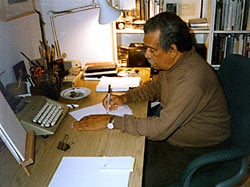
Fascinated by the thoughts of explorers.
Copyright © Anders Hallengren 2000
Photo: Anders Hallengren
Explorers
Walcott is also fascinated by thoughts of the first men to discover and visit the world to which he belongs. These were explorers like Columbus, Walter Raleigh, and James Cook, as well as rebels like Toussaint and Henri-Christophe. To Walcott, Robinson Crusoe, more than anybody else, is a real archetype, and his long poem, “Crusoe’s Island” (published in the 1965 volume The Castaway), contains in addition to a detailed geographic and psychological characterization, simple, lucid lines like the following ones:
Upon this rock the bearded hermit built
His Eden:
Goats, corn crop, fort, parasol, garden,
Bible for Sabbath, all the joys
But one
Which sent him howling for a human voice.
Exiled by a flaming sun
The rotting nut, bowled in the surf,
Became his own brain rotting from the guilt
Of heaven without his kind,
Crazed by such paradisal calm
The spinal shadow of a palm
Built keel and gunwale in his mind.
In the 1978 play Pantomime, Walcott used only two characters, Robinson and Friday, in an ironic, modernized variation of their personal relationship that takes place on the island of Tobago. In his important, autobiographical collection of poetry, Another Life, 1973, he also speaks about the task of those who first came over the seas to inhabit the American world:
We were blest with a virginal, unpainted world
with Adam’s task of giving things their names
An important part of Walcott’s poetry and drama has as a partly subconscious program, the “Caribbeanization” of earlier, European motives. Thus, when he studies and admires the plays of John Synge and his depiction of Aran fishermen, as well as the filmatic work of the Japanese director Akira Kurosawa, he works by creating St. Lucian counterparts, simple fishermen speaking their patois.

“Preparing the Net,” 1999, oil on canvas by Derek Walcott.
Copyright © Derek Walcott
The dramatic work
Walcott’s dramatic work is as important as his poetry. Today, he has written about twenty-five plays, although not all of them have been published. He has defined himself as “not only a playwright but a company,” the reason being that he has worked as much as an instructor and as founder of theatre companies as a playwright. After starting “St. Lucia Arts Guild” in 1950, he opened “Little Carib Theatre Workshop” in 1961. He had then hired a small troop of part-time actors, who could survive because they had other part-time occupations besides. They were nevertheless working under unsure economic conditions, with occasional contributions from the Rockefeller Foundation. In 1966, Walcott’s company changed its name to “Trinidad Theatre Workshop”. As its success gradually grew, the new company made guest performances abroad – in Jamaica, Guyana, Toronto (Canada), Boston, and New York (the USA). Walcott himself has worked at different places teaching, including Boston University as a professor of drama.
Among Walcott’s earlier plays, Ti-Jean and his Brothers has a background in Caribbean folklore, while Dream on Monkey Mountain, his dramatic masterpiece, takes place on his own island of St. Lucia. The latter work’s social inspiration derives from Jean-Paul Sartre’s theories about the black Orpheus, as well as from Frantz Fanon, the French sociologist who impressed the peoples of the Western colonies so deeply with his work Les Damnés de la Terre (1956).
Dream on Monkey Mountain
The Dream on Monkey Mountain (1967) belongs to the twentieth-century genre called dream plays, connected with works by playwrights such as Strindberg as well as by Synge and Soyinka. The play’s main character is Makak (French patois for “Ape”), a black charcoal-burner who comes to town, gets drunk, and is taken into custody by Corporal Lestrade, a mulatto guard who is the maintainer of law and order during the later years of the colonial power. In a dream scene of a mock trial that was probably inspired by Kafka and Hesse, Lestrade accuses Makak of being intoxicated and damaging the premises of a local salesman. However, in another vivid dream sequence, Makak is crowned king in the romantic Africa of his roots, surrounded by his wives, his warriors, and the masks of pagan gods.
In a second mock trial, a number of great Western characters (e.g., Plato, Ptolemy, Dante, Cecil Rhodes, Florence Nightingale) are accused of neglecting other races and sentenced to death by the African tribes. Lestrade has now given up his confession to the Western world, shouldered his black inheritance, and sworn allegiance to Makak. The poor charcoal-burner is acquitted from the charges, and able to withdraw to his West Indian world with a deepened sense of identity.
The dream visions in this play seem to belong both to Makak and to the collective atmosphere of the plot. Ironic effects appear throughout the events. At the same time as Makak’s romantic dream of Africa is presented, he cherishes a fantasy of a white protectress who takes care of him. But, as suggested by Lestrade, he gives up this dream, brutally beheading the woman with an African sword. This is a sacrifice that expresses a sound reaction against a fantasy life alienated from reality. Makak’s character also bears symbolic similarities with Christ: in prison, he is followed by two robbers, and from Good Friday he is able to look forward to the moment of resurrection on Easter Sunday. The prison can be understood as a symbol both of life itself and of colonial rule. In a sophisticated way, this play expresses central components of Walcott’s attitude to the political, racial, and psychological problems in his post-colonial world.
In Dream on Monkey Mountain, Walcott makes a great effort to interpret the nature of Caribbean identity. Colonialism has been important in damaging the human soul and humiliating the inhabitants of this part of the world. But there is no point trying to build castles in the air, as when Makak dreams of his African roots. At the end, in the epilogue, this simple-hearted visionary proletarian is acquitted, while Western civilization with its great characters is sentenced to death. Regardless of this, hate and revenge are negligible – in fact, negative – factors to the writer Walcott.
From Seville to Babylon
By Ti-Jean and His Brothers (1958), Walcott had more seriously started to embrace song and dance in the plot. He had been very successful with his first musicals, The Joker of Seville (1974) and O Babylon (1976). The former is a re-working of Tirso de Molina’s play El burlador de Sevilla, and deals with the Don Juan character and its sexual and moral aspects, while at the same time taking up folk traditions and folk music (calypso) from Trinidad. O Babylon goes back to Walcott’s experiences in Jamaica and deals with the opinions of a religious and political sect of this island, the Rastafarians, and their rejection of Western culture. In Dream on Monkey Mountain, the dances, the miming, and the masquerades take on an even wider role.
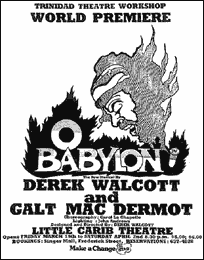
A poster done by Derek Walcott for the play “O Babylon”.
Copyright © Derek Walccot
The “Homeric” works
Omeros
From his early youth, Walcott had a great interest in both the sea and the Homeric world, calling the latter “an echo in the throat.” Comparatively recently, he devoted two works to this subject: Omeros (1990) and The Odyssey – A Stage Version (1993). Omeros is a work divided into one hundred and ninety-two songs, written in a rhythmic blank verse with a richness of poetic metaphors and similes. In the French title, Walcott makes poetic pun in that mer evokes the sense of both “sea” and “mother,” and “o” signifies the sound blown through a conch from the sea. This great work presents a reversible world, a colonial or post-colonial model corresponding to the original Homeric world. This is an epic poetic tale, with a multitude of different short stories, flashbacks, conversations, monologues, episodes, descriptions, and impressions, depicting in a minutely detailed way the Caribbean world and all its everyday life, its human beings, animals, nature, waters, and woods.
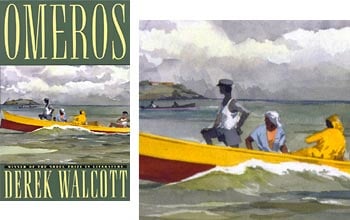
The book cover of “Omeros”, using the painting done by Derek Walcott (right).
Copyright © 1990 Farrar, Straus and Giroux
In Omeros, Homer himself appears in a row of different shapes. He is the blind Greek poet himself, the blind popular poet Seven Seas, the African griot or rhapsodist, the famous American painter Winslow H o m e r (with his paintings from the Atlantic Ocean), Virgil (the Roman counterpart to the Greek poet), and a blind barge-man who turns up on the stairs of the London church St. Martin-in-the-Fields with a manuscript refused by the editors. Even the personalities correspond to the Homeric ones: Philoctete, the wounded archer; Major Plunkett, a contemporary Philoctete; Achilles, here the son of an African slave; Hector, a fisherman; Helen, intentionally made into a very commonplace and approachable young Caribbean woman. Walcott’s post-colonial world, a world where many slaves had classic Greek names, in many different ways corresponds to Rome and Greece. How could the poet, he says, while listening to the quarrel of two fishermen in his hometown, avoid thinking of quarreling Homeric characters?
Walcott’s text is crowded with thoughts and reflections on history: “the farthest exclamations of history are written by a flag of smoke,” exemplified by Troy, Carthage, Pompeii; “art is history’s nostalgia,” implying that literature carries the same guilt as history and history is midden built on midden. Likewise, as a background to the life of people in our time, Walcott refers to violent events in history: the siege of Troy, the extermination of the Aruac people in the Caribbean by conquistadors, the eighteenth-century fights in the Caribbean between the English and French navies, as well as the prolonged catastrophe that extinguished most native Americans. Or the cruel attacks on African villages by slave traders, the perpetual tragedy of the captives who had to leave their homes, their families, their professions, and their tools, to try to create a new identity beyond the Atlantic; Ibos, Guineans, and many others.

“Domino Players”, (gouache on paper), done by Derek Walcott in 1999.
Copyright © Derek Walcott
The Odyssey
In a similar manner, the theatre production The Odyssey testifies to Walcott’s deep interest, or rather involvement, in the Homeric world. There are, indeed, similarities between Omeros and The Odyssey, but there are also major differences. As a dramatic work, The Odyssey is divided into two acts, the first with fourteen scenes, the second with six. The speeches are short, usually only one line each, with the exception of the songs sung by the blind Billy Blue, who is a more modern version of Homer. Now and then, in a number of lines, the speeches have endings that form natural rhymes. The characters are well-known from Homer and include Penelope, Odysseus’ wife, who has to wait for his return from Troy for twenty years; Telemachus, his son; his old nurse on Ithaca, Eurycleia, who is the first to recognize him when he comes back at last from his many adventures; and Eumaeus, the shepherd. There are also the kings visited by Telemachus when he seeks his father: Nestor of Pylos and Menelaos of Sparta. We meet with the sailors of Odysseus’ ship; King Alcinous and his daughter Nausicaa on the isle of the Phaeacians; Cyclops, the dangerous giant; Circe, the seductress; and in a short scene, corresponding to the sixth song of Homer’s work, Odysseus’ own mother Anticlea in the Underworld.
This does not mean, however, that all these characters are copies of those in the Greek Odyssey. Walcott is strikingly independent in forming different personalities. This work is not characterized by the same breadth and depth of the descriptions as in Omeros, but its dramatic verve, its liveliness, and its exquisite sense of humor distinguish it. We may accompany Odysseus from the victory at Troy, over his different stations on his way home, as well as we become more closely acquainted with Telemachus on his different expeditions and with Penelope in her difficult position in Ithaca. And the final scenes where Odysseus comes home and is at last recognized by Penelope and Telemachus do not lose any of the thrilling effects connected with the original Homeric situation. With its light, witty dialogue, it is in some ways more accessible than its poetic relative. Together, these two works provide some idea of Walcott’s rich cultural and political outlook over the seas and continents of the human world.
* Jöran Mjöberg (1913-2006) was professor of comparative literature and the author of literary studies as well as books about different countries (Iceland, Mexico, USA). His first work, Dikt och diktatur, appeared in the last year of World War II and was a survey of Swedish fiction and poetry that was inspired by a criticism and condemnation of Hitler and Nazi ideology (1933-1944). He has been lecturer at the University of Oslo (1947-1949) and taught Scandinavian languages and civilization at Harvard University from 1949 to 1953. Teaching at Växjö (Växjö Katedralskola) from 1953 to 1969 and at Lund University from 1969 to 1980, he has published a presentation of Latin American literature (Latinamerikanska förfatare, 1988), a study on visionary poetry during different epochs (De såg himmel och helvete, 1994), a book about the role of architecture in fiction and drama (Arkitektur i litteratur, 1999) and studies on the lyrical contribution of the Swedish poets Erik Axel Karlfeldt and Pär Lagerkvist.
First published 26 June 2001
Nobel Prizes and laureates
Six prizes were awarded for achievements that have conferred the greatest benefit to humankind. The 14 laureates' work and discoveries range from quantum tunnelling to promoting democratic rights.
See them all presented here.
